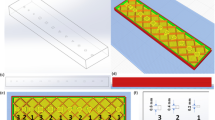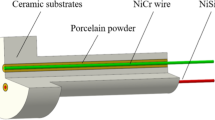Abstract
The aim of this study is to monitor the raster temperature distribution and width anomalies in a fused filament fabrication (FFF) process by an infrared (IR) array sensor. To achieve this goal, two experiments were conducted on a desktop FFF machine. For the first experiment, three normal samples with different raster widths were fabricated, and thermal images of the newly deposited rasters were collected during the process. To process the low-resolution images, a segmentation-based image processing method was proposed. The temperature distributions along the horizontal direction of the raster section and along the raster length were obtained. The temperature features that could indicate the raster widths were extracted and then fed to recognition models for training and testing. The classification performance of the models were evaluated based on the F-score. The models with high F1-scores could be used to recognise width anomalies online. For the second experiment, an abnormal sample with raster width anomalies was fabricated. The temperature features were extracted from the collected experimental data. The obtained features were then fed to the built and evaluated models to recognise the width anomalies online. The effectiveness of the monitoring method was validated by comparing the recognition results with the actual optical images. The support vector machine (SVM) and k-nearest neighbour (KNN) were adopted to build the recognition models. The F1-score and online recognition results of the models were compared. The comparison study shows that SVM is more suitable for our situation than KNN. A method for monitoring the temperature distribution and width anomalies of the FFF raster is provided in this paper. To the best of the authors’ knowledge, this is the first study to explore the actual temperature distribution along the horizontal direction of the raster section, and the first study to monitor the width anomalies of the raster in the FFF process.











Similar content being viewed by others
References
Peng A, Xiao X, Yue R (2014) Process parameter optimization for fused deposition modeling using response surface methodology combined with fuzzy inference system. Int J Adv Manuf Technol 73(1/4):87–100
Thrimurthulu K, Pandey PM, Reddy NV (2004) Optimum part deposition orientation in fused deposition modeling. Int J Mach Tools Manuf 44(6):585–594
Jin Y, He Y, Xue G et al (2015) A parallel-based path generation method for fused deposition modeling. Int J Adv Manuf Technol 77(5/8):927–937
Ahn D, Kweon JH, Kwon S et al (2009) Representation of surface roughness in fused deposition modeling. J Mater Process Technol 209(15/16):5593–5600
Chang DY, Huang BH (2011) Studies on profile error and extruding aperture for the RP parts using the fused deposition modeling process. Int J Adv Manuf Technol 53(9/12):1027–1037
Nuchitprasitchai S, Roggemann M, Pearce J (2017) Three hundred and sixty degree real-time monitoring of 3-D printing using computer analysis of two camera views. J Manuf Mater Process 1(1):2. https://doi.org/10.3390/jmmp1010002
Yang Z, Jin L, Yan Y et al (2018) Filament breakage monitoring in fused deposition modeling using acoustic emission technique. Sensors 18(3):749. https://doi.org/10.3390/s18030749
Li F, Yu Z, Yang Z et al (2019) Real-time distortion monitoring during fused deposition modeling via acoustic emission. Struct Health Monit 19(2):412–423
Chohan JS, Singh R (2017) Pre and post processing techniques to improve surface characteristics of FDM parts: a state of art review and future applications. Rapid Prototyp J 23(3):495–513
Wolszczak P, Lygas K, Paszko M et al (2018) Heat distribution in material during fused deposition modelling. Rapid Prototyp J 24(3):615–622
Kousiatza C, Karalekas D (2016) In-situ monitoring of strain and temperature distributions during fused deposition modeling process. Mater Des 97:400–406
Ji LB, Zhou TR (2010) Finite element simulation of temperature field in fused deposition modeling. Adv Mater Res Trans Tech Publ 97:2585–2588
Zhou X, Hsieh SJ (2017) Thermal analysis of fused deposition modeling process using infrared thermography imaging and finite element modeling. In Thermosense: Thermal Infrared Applications XXXIX, International Society for Optics and Photonics 10214:1021409. https://doi.org/10.1117/12.2262796
Zhou Y, Nyberg T, Xiong G et al (2016) Temperature analysis in the fused deposition modeling process. In: 2016 3rd international conference on information science and control engineering (ICISCE), IEEE, pp 678–682
Zhou X, Hsieh SJ, Sun Y (2017) Experimental and numerical investigation of the thermal behaviour of polylactic acid during the fused deposition process. Virtual Phys Prototyp 12(3):221–233
Roy M, Yavari R, Zhou C et al (2019) Prediction and experimental validation of part thermal history in the fused filament fabrication additive manufacturing process. J Manuf Sci Eng 141(12):121001. https://doi.org/10.1115/1.4045056
Mohamed OA, Masood SH, Bhowmik JL (2015) Optimization of fused deposition modeling process parameters: a review of current research and future prospects. Adv Manuf 3(1):42–53
Sahu RK, Mahapatra S, Sood AK (2013) A study on dimensional accuracy of fused deposition modeling (FDM) processed parts using fuzzy logic. J Manuf Sci Prod 13(3):183–197
Kumar GP, Regalla SP (2012) Optimization of support material and build time in fused deposition modeling (FDM). Appl Mech Mater Trans Tech Publ 110:2245–2251
Sood AK, Ohdar RK, Mahapatra SS (2010) Parametric appraisal of mechanical property of fused deposition modelling processed parts. Mater Des 31(1):287–295
Percoco G, Lavecchia F, Galantucci LM (2012) Compressive properties of FDM rapid prototypes treated with a low cost chemical finishing. Res J Appl Sci Eng Technol 4(19):3838–3842
Rayegani F, Onwubolu GC (2014) Fused deposition modelling (FDM) process parameter prediction and optimization using group method for data handling (GMDH) and differential evolution (DE). Int J Adv Manuf Technol 73(1/4):509–519
Masood SH, Mau K, Song W (2010) Tensile properties of processed FDM polycarbonate material. Mater Sci Forum Trans Tech Publ 654:2556–2559
Arivazhagan A, Masood S, Sbarski I (2011) Dynamic mechanical analysis of FDM rapid prototyping processed polycarbonate material. In: Proceedings of the 69th annual technical conference of the society of plastics engineers, pp 950–955
Arivazhagan A, Masood S (2012) Dynamic mechanical properties of ABS material processed by fused deposition modelling. Int J Eng Res Appl 2(3):2009–2014
Widodo A, Kim EY, Son JD et al (2009) Fault diagnosis of low speed bearing based on relevance vector machine and support vector machine. Expert Syst Appl 36(3):7252–7261
Jegadeeshwaran R, Sugumaran V (2015) Fault diagnosis of automobile hydraulic brake system using statistical features and support vector machines. Mech Syst Signal Process 52:436–446
Senanayaka JSL, Kandukuri ST, Van Khang H et al (2017) Early detection and classification of bearing faults using support vector machine algorithm. In: 2017 IEEE workshop on electrical machines design, control and diagnosis (WEMDCD), IEEE, pp 250–255
Vapnik V (1999) The nature of statistical learning theory. Springer science & business media, New York
Wang TM, Jin H, Xi JT (2006) The adhesive mechanism and thermal analysis of fibers in the FDM process. J Shanghai Jiaotong Univ 40(7):1230–1233
Cover T, Hart P (1967) Nearest neighbor pattern classification. IEEE Trans Inf Theory 13(1):21–27
Acknowledgments
Our work is funded by the National Natural Science Foundation of China (Grant Nos. 51675481 and 51905335), and the Shanghai Science and Technology Committee Research Project (Grant No. 19040501500).
Author information
Authors and Affiliations
Corresponding author
Rights and permissions
About this article
Cite this article
Li, F., Yu, ZH., Li, H. et al. Real-time monitoring of raster temperature distribution and width anomalies in fused filament fabrication process. Adv. Manuf. 10, 571–582 (2022). https://doi.org/10.1007/s40436-021-00385-8
Received:
Revised:
Accepted:
Published:
Issue Date:
DOI: https://doi.org/10.1007/s40436-021-00385-8




